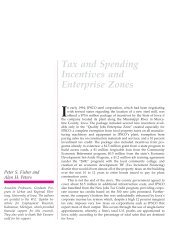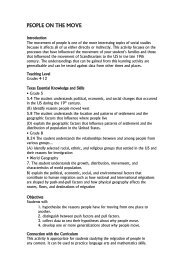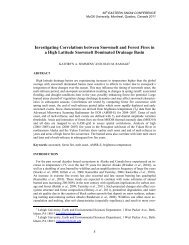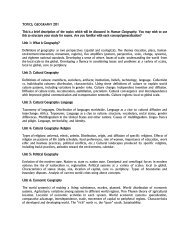Texas Social Studies Framework - Department of Geography ...
Texas Social Studies Framework - Department of Geography ...
Texas Social Studies Framework - Department of Geography ...
Create successful ePaper yourself
Turn your PDF publications into a flip-book with our unique Google optimized e-Paper software.
48<br />
48<br />
Figure 22: Teaching Students a Concept<br />
Concept: Refugee (World <strong>Geography</strong> TEKS 6, 14, 18, 21)<br />
1) Identify a set <strong>of</strong> examples and non-examples illustrating the concept and place them in a logical order. Include<br />
at least one example that serves as a model.<br />
Concept Definition: Victims <strong>of</strong> political violence who seek refuge outside their country.<br />
_ Model: Large numbers <strong>of</strong> Vietnamese fled Vietnam following the fall <strong>of</strong> Saigon, 1975.<br />
_ Other examples: Palestinian refugees fled Israel in 1948-1949. In 1995, Hutus and Tutsis fled Rwanda for<br />
the Congo to escape ethnic strife after their president was thought to have been assassinated by members <strong>of</strong><br />
the opposing ethnic group. Guatemalans fled to Mexico and the United States to escape political oppression<br />
in their own nation.<br />
_ Non-examples: Criminals who escape their punishment by fleeing to another country; individuals unhappy<br />
with their government who travel abroad; individuals seeking economic gain who move to other countries.<br />
2) Develop materials or oral instructions with a set <strong>of</strong> cues, directions, questions, and student activities that draw<br />
attention to the critical attributes, similarities, and differences in the examples and non-examples used to define the<br />
concept.<br />
3) Focus student attention on the model. What are its attributes and characteristics?<br />
_ Critical attributes: victim, political violence, seeking refuge and safety, in another country.<br />
_ Noncritical attributes: Country <strong>of</strong> origin, age, gender, educational level, socioeconomic status, race,<br />
religion.<br />
4) Ask students to compare all the examples with the model; provide feedback to students on their comparisons.<br />
5) Ask students to develop a definition <strong>of</strong> the concept or state it for them.<br />
6) Place the concept in relation to other student knowledge; try to attach this information to existing student<br />
knowledge structures (schema).<br />
7) Give students examples and non-examples to assess whether students understand the concept. Ask students to<br />
generate additional examples or apply the concept to new situations.<br />
The deductive approach is opposite. Students are<br />
presented with a theory, hypothesis, or generalization and<br />
are asked to find evidence to support or refute it. The key<br />
concept components <strong>of</strong> the generalization are clarified<br />
and the teacher provides materials, instructions, and<br />
assistance for the students to verify the generalization.<br />
Direct Instruction<br />
Teachers today recognize the difference between telling<br />
and teaching. We know students learn most effectively<br />
through personal effort and engagement in activities, not<br />
because we have told them something. While direct<br />
instruction and lectures are not all good, they are not all<br />
bad either. At times it is efficient and wise to provide<br />
information directly to students, for example, to present<br />
baseline information, to explain a new skill, to model a<br />
thinking process, or to provide clear guidance and<br />
Chapter 5: The Teaching-Learning System: Curriculum, Instruction, and Assessment<br />
information to students before they proceed to grapple<br />
with learning on their own. The typical direct instruction<br />
teaching strategy includes six steps: 1) daily review;<br />
2) presentation <strong>of</strong> new material; 3) guided practice;<br />
4) feedback; 5) independent practice; 6) periodic<br />
reviews.<br />
Collaborative Processes<br />
Collaboration means working together. Research shows<br />
that collaborative work supports greater retention <strong>of</strong><br />
subject matter, improves attitudes toward learning, and<br />
teaches students how to get along with each other. Some<br />
useful strategies include collaborative learning techniques<br />
(see Figure 23): peer, cross-age, and cross-ability<br />
tutoring; and reciprocal teaching involving summarizing,<br />
generating questions, clarifying, and predicting (Morton,<br />
1996).
















